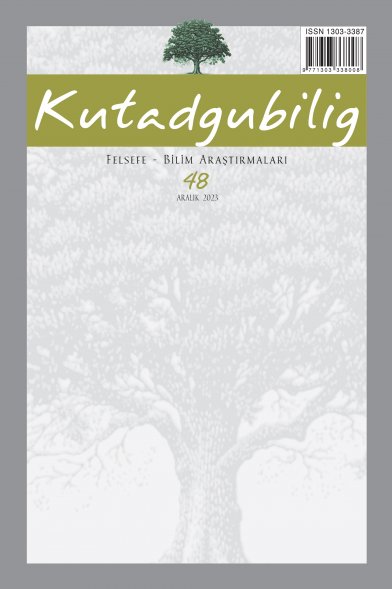Bilimde İdealleşme Kullanımı ve Tarihsel İki Örnek: Descartes ve El-Bettani
Bilimde idealleştirme kullanımı bilim felsefesinde önemli tartışmalara neden olmaktadır. İdealleştirme kavramı bu dünyadaki nesneler için yanlış olduğunu bildiğimiz sanı, önerme veya tümcelere işaret etmektedir. Yani, idealleştirmeler gerçek dünyanın nesnelerinin nasıl davrandıklarını yanlış betimleyen ifadelerdir. Gerçek dünyanın karmaşık yapısı ve hesaplama yapmaktaki sınırlı kapasitemiz nedeniyle, idealleştirmeler bilimde kaçınılmaz olarak kullanılmaktadır. Bu çalışmanın amacı, bilimde ilk kez idealleştirme kullanımı Galileo'ya atfedilse de, Descartes ve el-Bettanî'nin bilimsel çalışmalarında idealleştirme kullanan iki önemli kişilik olduğunu ortaya koymaktır. Descartes, hareket yasalarını ve evrendeki hareket miktarının hesaplanması ile ilgili yaptığı çalışmalarda idealleştirme kullanırken; el-Bettanî, Güneşin yörüngesini ve ekinoksları hesaplarken güneşteki paralaksı yok sayarak idealleştirme kullanmıştır.
Use of Idealization in Science and the Two Historical Examples: Descartes and Al-Bettani
Use of idealizations in science brings about significant discussions in phi-losophy of science. The concept "idealization" stands for any assumptions, propositions or statements known as false for objects in the actual world. That is, idealizations are false descriptions of how the objects in the real world behave. Due to complexity of the actual world and our limited ca-pacity in computation, scientists inevitably employ idealizations. The present study aims to propose that even though Galileo is known as the first scien-tists using idealization, Descartes and al-Battanî are two impressive figures who use idealization in science. Descartes applies to idealization while he formulates laws of motion and principles for calculating quantity of motion in the universe. In the determination of Sun's orbit and calculation of Equinoxes, al-Battanî uses an idealization by ignoring solar parallaxes.
___
Barr, W. F. (1971). “A Syntactic and Semantic Analysis of Idealizations in Science”, Philosophy of Science, 38, s. 258-272. Blackwell, R. J. (1969). Discovery in the Physical Sciences. London: University of Notre Dame Press. Cartwright, N. (1983). How the Laws of Physics Lie. Oxford University Press, Oxford, UK. Descartes, R. (1997). Felsefenin İlkeleri. (Çeviren: Mehmet Karasan). İstanbul: MEB Yayınları. Duhem, P. (1954). The Aim and Structure of Physical Theory. (Çeviren: Philip P. Weiner). Princeton, New Jersey: Princeton University Pres. Eyim, A. (2005). On the Significance of Idealizations in Science. Master Thesis, Ankara: METU Eyim, A. (2006). “Harran’dan Modern Bilime bir Köprü: El-Bettani”, I. Uluslara-rası Katılımlı Din, Bilim ve Felsefe Tarihinde Harran Okulu Sempozyumu Bildiriler Kitabı. Şanlıurfa: Şelale Matbaası, s. 333-340. Husserl, E. (2000). Logical Investigations. (Çeviren: J. N. Findlay). Amherst: Humanity Boks. Laymon, R. (1989). “Cartwright and the Lying Laws of Physics,” The Journal of Philosophy, 86, s. 353- 372. Lind, H. (1993). “A Note on Fundamental Theory and Idealizations in Ecomonics and Physics”, British Journal for the Philosophy of Science, 44, s. 493-503. Maeyama, Y. (1998). “Determination of the Sun’s Orbit: Hipparcus, Ptolemy, al-Bettanî, Copernicus, Tycho Brahe”, Arch. History of Exact Science, 53, s. 1-49. Ronan, C. A. (2003). Bilim Tarihi: Dünya Kültürlerinde Bilimin Tarihi ve Geliş-mesi. (Çeviren: Prof. Dr. Ekmeleddin İhsanoğlu ve Prof. Dr. Feza Günergun). Ankara : Tübitak Popüler Bilim Kitapları. Shaffer, M. (2000). Idealization and Empirical Testing. Ph.Dissertation. Florida: Coral Gables. Slowik, E. (2002). Cartesian Spacetime, Dordrecht, Boston and London: Kluwer Academic Publishers. Unat, Y. (2006). “Bettanî ve Zic-i Sabi Adlı Astronomi Eseri”, I. Uluslararası Ka-tılımlı Din, Bilim ve Felsefe Tarihinde Harran Okulu Sempozyumu Bildiri-ler Kitabı. Şanlıurfa: Şelale Matbaası, s. 347-368. Van Fraassen, B. C. (1980). The Scientific Image. Oxford: Clarendon Press. Westfall, R. S. (1998). Modern Bilimin Oluşumu. (Çev. İsmail Hakkı Duru). An-kara: Tübitak Popüler Bilim Kitapları. Winn, R. B. (1956). “Mind and Nature”, Philosophy of Science, 13, s. 41- 52.- ISSN: 1303-3387
- Yayın Aralığı: Yılda 2 Sayı
- Başlangıç: 2002
- Yayıncı: Dergah Yayınları A.Ş.
Sayıdaki Diğer Makaleler
Franz Brentano'da İç Algı ve İç Gözlem Arasındaki Fark
Sonsuzluk Kavramı Bağlamında Hegelci Mutlak İdealizm
'Hiç' Nerdeyse Mucizeler Görür! Psikolojisi ve Dinde Ben ve Ben-Dışı
Bilimde İdealleşme Kullanımı ve Tarihsel İki Örnek: Descartes ve El-Bettani
Değer Problemi ve Dünya Görüşü İlgisine Kısa Bir Bakış
Erken Klasik Arap Dilbilgisel Düşüncesinde (EKADD) Kıyas ve Temelleri
Heinrich OTTEN, Christel RÜSTER
